Mary Ward and the Institute of Mary
Foundress, born 23 January, 1585; died 23 January, 1645; eldest
daughter of Marmaduke Ward and Ursula Wright, and connected by blood
with most of the great Catholic families of Yorkshire. She entered a
convent of Poor Clares at St.-Omer as lay sister in 1606. The following
year she founded a house for Englishwomen at Gravelines, but not finding
herself called to the contemplative life, she resolved to devote
herself to active work. At the age of twenty-four she found herself
surrounded by a band of devoted companions determined to labour under
her guidance. In 1609 they established themselves as a religious
community at St.-Omer, and opened schools for rich and poor. The venture
was a success, but it was a novelty, and it called forth censure and
opposition as well as praise.
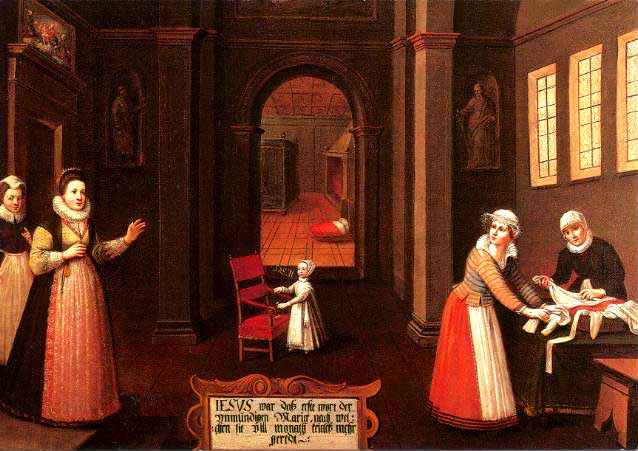
The first word that Mary Ward uttered was “Jesus”, after which she did not speak again for several months.
Her idea was to enable women to do for the Church in their proper
field, what men had done for it in the Society of Jesus. The idea has
been realized over and over again in modern times, but in the
seventeenth century it met with little encouragement. Uncloistered nuns
were an innovation repugnant to long- standing principles and traditions
then prevalent. The work of religious women was then confined to
prayer, and such good offices for their neighbour as could be carried on
within the walls of a convent. There were other startling differences
between the new institute and existing congregations of women, such as
freedom from enclosure, from the obligation of choir, from wearing a
religious habit, and from the jurisdiction of the diocesan.
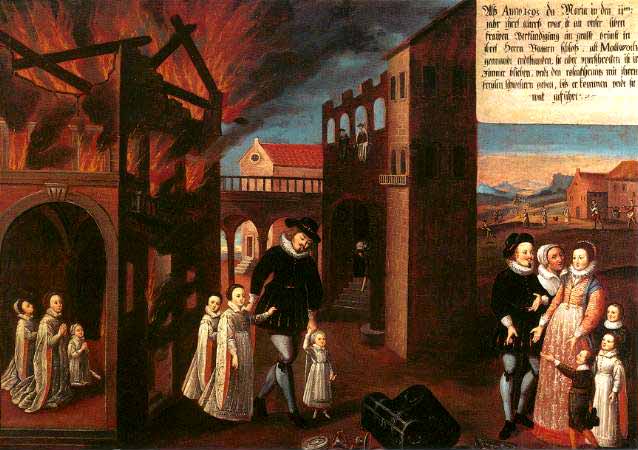
In
the year 1595, when Mary was in her eleventh year, on the feast of the
Annunciation, a great fire broke out at her father’s mansion at Mulwith.
She was not alarmed, but remained in a room, saying the rosary with her
sisters until their father came to fetch them.
Moreover her scheme was put forward at a time when there was much
division amongst English Catholics, and the fact that it borrowed so
much from the Society of Jesus (itself an object of suspicion and
hostility in many quarters) increased the mistrust it inspired. Measures
recognized as wise and safe in these days were untried in hers, and her
opponents called for some pronouncement of authority as to the status
and merits of her work. As early as 1615, Suarez and Lessius had been
asked for their opinion on the new institute. Both praised its way of
life. Lessius held that episcopal approbation sufficed to render it a
religious body; Suarez maintained that its aim, organization, and
methods being without precedent in the case of women, required the
sanction of the Holy See.
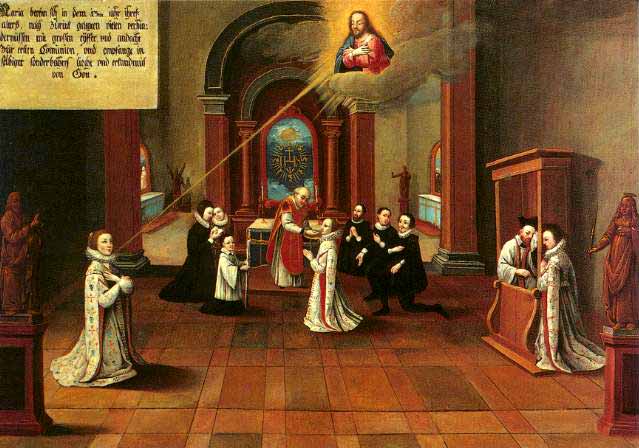
In
her thirteenth year, after overcoming many obstacles, Mary prepared
with great zeal and devotion for her first communion, on which occasion
she received much light and knowledge from God.
St. Pius V had declared solemn vows and strict papal enclosure to be
essential to all communities of religious women. To this law the
difficulties of Mary Ward were mainly due, when on the propagation of
her institute in Flanders, Bavaria, Austria, and Italy, she applied to
the Holy See for formal approbation. The Archduchess Isabella, the
Elector Maximilian I, and the Emperor Ferdinand II had welcomed the
congregation to their dominions, and together with such men as Cardinal
Federigo Borromeo, Fra Domenico de Gesù, and Father Mutio Vitelleschi,
General of the Society of Jesus, held the foundress in singular
veneration. Paul V, Gregory XV, and Urban VIII had shown her great
kindness and spoken in praise of her work, and in 1629 she was allowed
to plead her own cause in person before the congregation of cardinals
appointed by Urban to examine it. The “Jesuitesses”, as her congregation
was designated by her opponents, were suppressed in 1630.
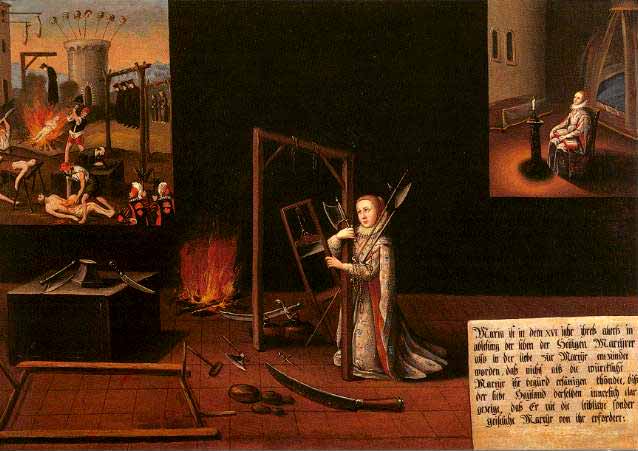
When
Mary was sixteen and read the lives of the holy martyrs, she was seized
with such a burning desire to follow their example that she felt only
martyrdom itself could satisfy her longing, until our Saviour revealed
to her interiorly that what He required of her was spiritual rather than
bodily martyrdom.
Her work however was not destroyed. It revived gradually and
developed, following the general lines of the first scheme. The second
institute was at length approved as to its rule by Clement XI in 1703,
and as an institute by Pius IX in 1877.
At the express desire of Pope Urban Mary went to Rome, and there as
she gathered around her the younger members of her religious family,
under the supervision and protection of the Holy See, the new institute
took shape. In 1639, with letters of introduction from Pope Urban to
Queen Henrietta Maria, Mary returned to England and established herself
in London. In 1642 she journeyed northward with her household and took
up her abode at Heworth, near York, where she died. The stone over her
grave in the village churchyard of Osbaldwick is preserved to this day.
For the history of the institute subsequent to the death of Mary Ward, see INSTITUTE OF MARY, below.
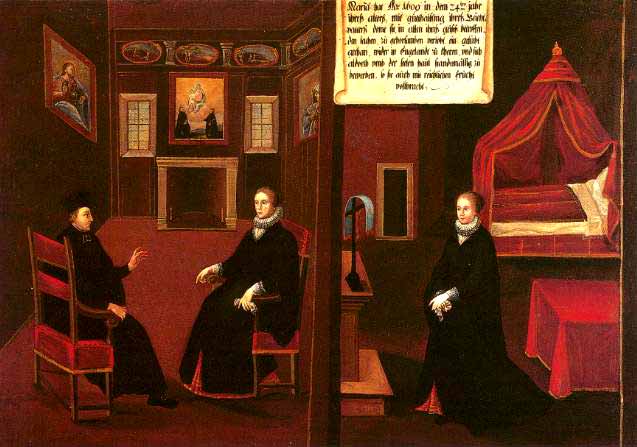
In
1606, Mary being then 21, left home with her confessor’s consent, and
took a ship to Saint-Omer accompanied by Mrs Bentley to whose care she
had been entrusted. Later in 1609, with the approval of her confessor
whom she had vowed to obey in all spiritual matters, she made a vow to
return to England and to labour there for the salvation of souls, in
conformity with her state. Her labours produced abundant fruit.
CHAMBERS, Life of Mary Ward (London, 1885); SALOME, Mother M. Mary Ward, A Foundress of the Seventeenth Century (London, 1901); MORRIS, The Life of Mary Ward in The Month,
LV. The oldest sources for the history of Mary Ward are the MS. lives
by WIGMORE (English), PAGETI (Italian, 1662. Nymphenburg Archives).
BISSEL (Latin, 1667 or 1668, of which there is a copy in the Westminster
Diocesan Archives), LOHNER (German, 1689, Nymphenburg Archives). The
most important of printed Lives are: KHAMM (1717); FRIDL (c. 1727), and
BUCHINGER.
_____________________________
The official title of the second congregation founded by Mary Ward.
Under this title Barbara Babthorpe, the fourth successor Mary Ward as
“chief superior”, petitioned for and obtained the approbation of its
rule in 1703. It is the title appended to the signatures of the first
chief superiors, and mentioned in the “formula of vows” of the first
members. “Englische Fräulein”, “Dame Inglesse”, “Loretto Nuns”, are
popular names for the members of the institute in the various countries
where they have established themselves. On the suppression, in 1630, of
Mary Ward’s first congregation, styled by its opponents the
“Jesuitesses”, the greater number of the members returned to the world
or entered other religious orders. A certain number, however, who
desired still to live in religion under the guidance of Mary Ward, were
sheltered with the permission of Pope Urban VIII in the Paradeiser Haus,
Munich, by the Elector of Bavaria, Maximilian I.

While
Mary was in London, her zealous words and gift of persuasion induced
her aunt Miss Gray to talk to a priest of the Society of Jesus with a
view to accepting the true faith. While there, Mary succeeded in
bringing back to the faith on her deathbed and obstinate heretic who
received the Holy Viaticum with great devotion.
Thence some of the younger members were transferred at the pope’s
desire to Rome, there to live with Mary Ward and be trained by her in
the religious life. Her work, therefore, was not destroyed, but
reconstituted with certain modifications of detail, such as subjection
to the jurisdiction of the ordinary instead of to the Holy See
immediately, as in the original scheme. It was fostered by Urban and his
successors, who as late as the end of the seventeenth century granted a
monthly subsidy to the Roman house. Mary Ward died in England at
Heworth near York in 1645, and was succeeded as chief superior by
Barbara Babthorpe, who resided at Rome as head of the “English Ladies”,
and on her death was buried there in the church of the English College.
She was succeeded as head of the institute by Mary Pointz, the first
companion of Mary Ward. The community at Heworth removed to Paris in
1650. In 1669 Frances Bedingfield, one of the constant companions of
Mary Ward, was sent by Mary Pointz to found a house in England. Favoured
by Catherine of Braganza, she established her community first in St.
Martin’s Lane, London, and afterwards at Hammersmith. Thence a colony
moved to Heworth, and finally in 1686 to the site of the present
convent, Micklegate Bar, York. In addition to that at Munich, two
foundations had meantime been made in Bavaria—at Augsburg in 1662, at
Burghausen in 1683.
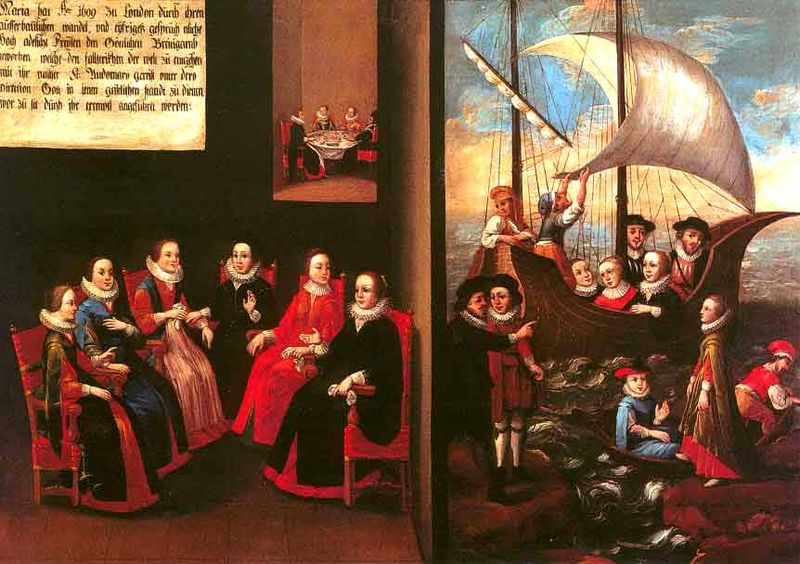
During
her stay in London in 1609, Mary’s edifying life and persuasive words
won over several young ladies of noble birth to the service of the
Divine Spouse. Inspired by her example and to avoid the snares of the
world, they crossed over with her to Saint-Omer, to serve God in the
religious state under Mary’s direction.
At the opening of the eighteenth century the six houses of Munich,
Augsburg, Rome, Burghausen, Hammersmith, and York were governed by local
superiors appointed by the chief superior, who resided for the most
part at Rome, and had a vicaress in Munich. Thus, for seventy years the
institute carried on its work, not tolerated only, but protected by the
various ordinaries, yet without official recognition till the year 1703,
when at the petition of the Elector Maximilian Emanuel of Bavaria, Mary
of Modena, the exiled Queen of England, and others, its rule was
approved by Pope Clement XI. It was not in accordance with the
discipline of the Church at that time to approve any institute of simple
vows. The pope was willing, however, to approve the institute
as such,
if the members would accept enclosure. But fidelity to their
traditions, and experience of the benefit arising from non-enclosure in
their special vocation, induced them to forego this further
confirmation. The houses in Paris and in Rome were given up about the
date of the confirmation of the rule in 1703. St. Pölten (1706) was the
first foundation from Munich after the Bull of Clement XI. In 1742 the
houses in Austria and its dependencies were by a Bull of Benedict XIV
made a separate province of the institute, and placed under a separate
superior-general. The Austrian branch at present (1909) consists of
fourteen houses.
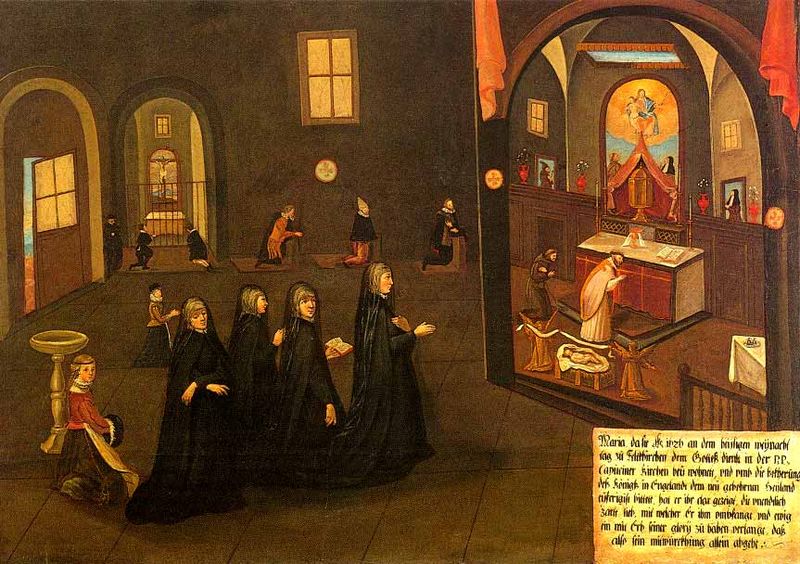
On
Christmas Day 1626, Mary attended Mass in the Capuchin Church at
Feldkirch and prayed most earnestly to the new-born Saviour for the
conversion of the King of England. God revealed to her the infinitely
tender love He had for the King and how much He desired him to share His
eternal glory, but that the King’s cooperation was wanting.
In Italy, Lodi and Vicenza have each two dependent filials. When the
armies of the first Napoleon overran Bavaria in 1809, the mother-house
in Munich and the other houses of the institute in Germany—Augsburg,
Burghausen, and Altötting excepted—were broken up and the communities
scattered. On the restoration of peace to Europe, King Louis I of
Bavaria obtained nuns from Augsburg, and established them at
Nymphenburg, where a portion of the royal palace was made over to them.
In 1840 Madame Catherine de Graccho, the superior of this house, was
appointed by Gregory XVI general superior of the whole Bavarian
institute. At the present day there are 85 houses under Bavaria, with
1153 members, 90 Postulants, 1225 boarders, 11,447 day pupils and 1472
orphans. Four houses in India, one at Rome, and two in England are
subject to Nymphenburg. The house in Mainz escaped secularization, being
spared by Napoleon on the condition that all connection with Bavaria
should cease. It is now the mother-house of a branch which has eight
filial houses.

In
1626, when Mary was on her way to Munich for the first time, not far
from the Isarberg she told her companions that God had revealed to her
in prayer that His Highness the Elector would provide them with a
suitable house and a yearly means of support. This effectively took
place soon after their arrival in Munich.
When vigour was reviving in the institute abroad, the Irish branch
was founded (1821) at Rathfarnham, near Dublin, by Frances Ball, an
Irish lady, who had made her novitiate at York. There are now 19 houses
of the institute in Ireland, 13 subject to Rathfarnham and 6 under their
respective bishops. The dependencies of Rathfarnham are in all parts of
the world—3 houses in Spain, 2 in Mauritius, 2 at Gibraltar, 10 in
India, 2 in Africa, 10 in Australia, with a Central Training College for
teachers at Melbourne (1906). There are 8 houses of the institute in
Canada, 3 in the United States, 7 in England, about 180 houses in all.
Owing to the variety of names and the independence of branches and
houses, the essential unity of the institute is not readily recognized.
The “English Virgins”, or “English Ladies”, is the title under which the
members are known in Germany and Italy, whilst in Ireland, and where
foundations from Ireland have been made, the name best known is “Loretto
Nuns”, from the name of the famous Italian shrine given to the
mother-house at Rathfarnham. Each branch has its own novitiate, and
several have their special constitutions approved by the Holy See. The
“Institute of Mary” is the official title of all; all follow the rule
approved for them by Clement XI, and share in the approbation of their
institute given by Pius IX, in 1877.
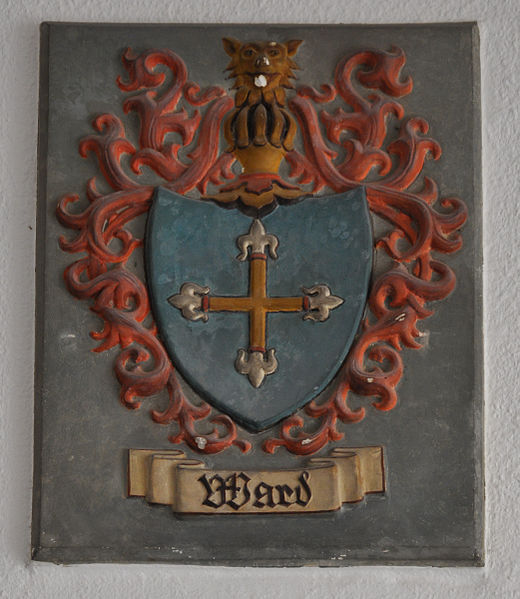
The Coat of Arms of Mary Ward over the Gateway in Mainz.
The sisters devote themselves principally to the education of girls
in boarding-schools and academies, but they are also active in primary
and secondary schools, in the training of teachers, instruction in the
trades and domestic economy, and the care of orphans. Several members of
the institute have also become known as writers.
M. LOYOLA (Catholic Encyclopedia)










